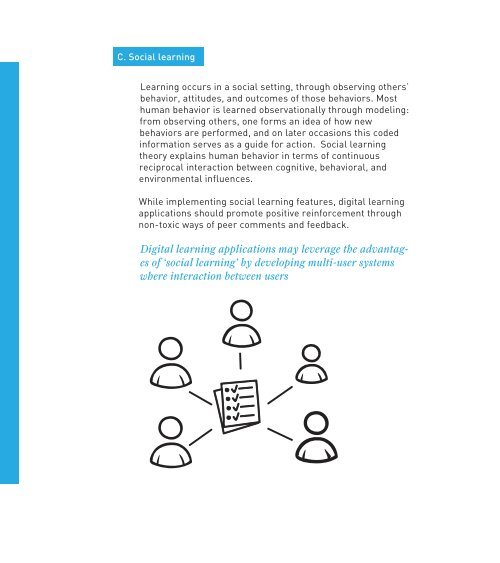Industry Guidelines on Digital Learning: Discussion Draft
The guidelines offered in this document are a first draft to provide a holistic system of characteristics and parameters important for delivering active and engaging learning through digital solutions.
The guidelines offered in this document are a first draft to provide a holistic system of characteristics and parameters important for delivering active and engaging learning through digital solutions.
You also want an ePaper? Increase the reach of your titles
YUMPU automatically turns print PDFs into web optimized ePapers that Google loves.
C. Social learning<br />
<strong>Learning</strong> occurs in a social setting, through observing others’<br />
behavior, attitudes, and outcomes of those behaviors. Most<br />
human behavior is learned observati<strong>on</strong>ally through modeling:<br />
from observing others, <strong>on</strong>e forms an idea of how new<br />
behaviors are performed, and <strong>on</strong> later occasi<strong>on</strong>s this coded<br />
informati<strong>on</strong> serves as a guide for acti<strong>on</strong>. Social learning<br />
theory explains human behavior in terms of c<strong>on</strong>tinuous<br />
reciprocal interacti<strong>on</strong> between cognitive, behavioral, and<br />
envir<strong>on</strong>mental influences.<br />
i. MULTI-USER OFFLINE<br />
The users can interact with other users offline.<br />
Interacti<strong>on</strong> in learning is a necessary and fundamental<br />
process for knowledge acquisiti<strong>on</strong> and the development<br />
of both cognitive and physical skills. These interacti<strong>on</strong>s<br />
may be designed to increase understanding, share<br />
perspectives, resolve c<strong>on</strong>flicts etc.<br />
While implementing social learning features, digital learning<br />
applicati<strong>on</strong>s should promote positive reinforcement through<br />
n<strong>on</strong>-toxic ways of peer comments and feedback.<br />
<strong>Digital</strong> learning applicati<strong>on</strong>s may leverage the advantages<br />
of ‘social learning’ by developing multi-user systems<br />
where interacti<strong>on</strong> between users<br />
<strong>Digital</strong> learning applicati<strong>on</strong>s should enable, incentivize<br />
or provide flexibility to promote offline user interacti<strong>on</strong>s<br />
with other learners or educators which may<br />
then be fed back into the applicati<strong>on</strong> when users get<br />
<strong>on</strong>line.<br />
ii. MULTI-USER ONTLINE<br />
The users can interact with other users <strong>on</strong>line.<br />
Collaborating with other learners to find soluti<strong>on</strong> to a<br />
comm<strong>on</strong> problem requires the user to dem<strong>on</strong>strate<br />
understanding and tests their ability to work amicably.<br />
This ensures each learner has a specialist knowledge as<br />
well as a general comm<strong>on</strong> knowledge. ,<br />
<strong>Digital</strong> learning applicati<strong>on</strong>s may encourage<br />
cross-functi<strong>on</strong>al cooperati<strong>on</strong> by requiring learners<br />
with different strengths to work together<br />
FOREWORD | INTRODUCTION | GUIDELINES | CONCLUSION | AUTHORS & REVIEWERS | REFERENCES<br />
PURPOSE | PRINCIPLES | STRUCTURE | MANDATORY GUIDELINES | RECOMMENDED GUIDELINES


















